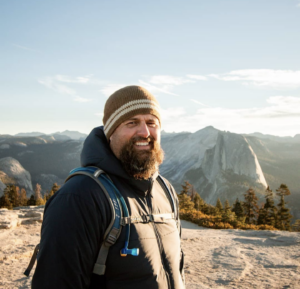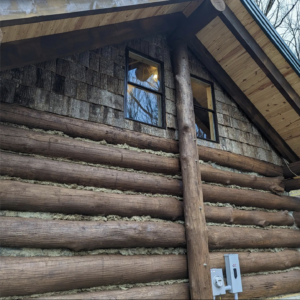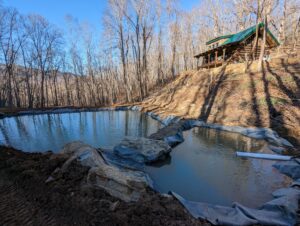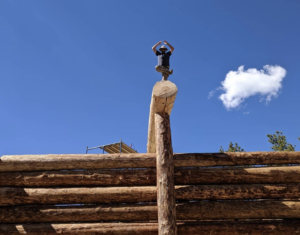5 Questions with Ronnie Wiley, Owner of Cool New Triple Crown Cabin
Deciding to tackle the Triple Crown is a COMMITMENT. It’s beautiful and worthwhile, but it takes a lot of planning, logistics, and grit to complete. Now, you have one less thing to coordinate when attempting this challenge–lodging! That’s where Ronnie Wiley and his new Triple Crown Cabin come into play. Ronnie is committed to sustainability, the outdoors, and getting back to nature through his business. Read on for a little more info about Ronnie, his craft, and the new Triple Crown Cabin.
Wiley Log Homes uses the tag line “Hand Crafted Traditions.” Tell us more about that and your business.
I grew up every year going to a log cabin at Dale Hollow Lake on the border of Tennessee and Kentucky for summer vacation with my family. It wasn’t fancy—two bedrooms, one bath, no AC, barely enough electricity to run the lights, but it holds some of my fondest childhood memories. Log homes have a way of reconnecting people to each other, to nature, to the earth, to the past, and they have a way of getting people to slow down and appreciate the important things in life. I started Wiley Log Homes in hopes of being able to build spaces for people to do those things. Since our start over 15 years ago we have built homes all over the U.S.—Washington State, Colorado, Michigan, Alabama, New York, and a lot of places in between. We’ve built homes as small as 150 square feet and some over 10,000 square feet. We often build with trees from the property we are building on, and we specialize in helping people who want to serve as their own general contractor and finish out their homes themselves, often debt free. We are launching a completely online school this spring to teach people how to build their own log homes for those who want the joy of doing it from beginning to end. You can find more info here: learntobuildloghomes.com
barely enough electricity to run the lights, but it holds some of my fondest childhood memories. Log homes have a way of reconnecting people to each other, to nature, to the earth, to the past, and they have a way of getting people to slow down and appreciate the important things in life. I started Wiley Log Homes in hopes of being able to build spaces for people to do those things. Since our start over 15 years ago we have built homes all over the U.S.—Washington State, Colorado, Michigan, Alabama, New York, and a lot of places in between. We’ve built homes as small as 150 square feet and some over 10,000 square feet. We often build with trees from the property we are building on, and we specialize in helping people who want to serve as their own general contractor and finish out their homes themselves, often debt free. We are launching a completely online school this spring to teach people how to build their own log homes for those who want the joy of doing it from beginning to end. You can find more info here: learntobuildloghomes.com
You recently built a log cabin you’re calling the Triple Crown; what’s the story behind that?
The first time I summited McAfee’s Knob and looked down on the Catawba Valley, I knew that was where I wanted to spend the rest of my life. After five years of looking for the right piece of property, I finally found the place—21 acres on Gravelly Ridge, the small ridge that runs through the middle of Catawba Valley. We harvested logs from the property and built our forever home here. We built at the highest point of our property, but there was an old homesite where previous owners had lived and farmed the property down in the valley by a spring. One of the deciding factors in choosing our property is its proximity to all the Triple Crown trailheads; we can be to any of them in less than 12 minutes. A friend suggested I could build a cabin there to help fill the need for unique places to stay when people are in town to do any or all the triple-crown peaks that our section of the Appalachian Trail is so well known for. And thus, the ball was set in motion for the Triple Crown Cabin.
Tell us more about the Triple Crown Cabin?

We wanted our visitors to have a place where they could feel the beauty of nature before they ever went outside of the cabin, but to also showcase that sustainable, well-built homes are possible. We harvested the tulip poplar trees from our property for the log walls. We cut them as the sap came up in the spring, which meant we could harvest the bark as we peeled it to use as siding for gables and the dormer. A majority of the lumber used in the construction was harvested and milled on the property using sustainable logging methods. We are using the spring to provide all the water needs (it passed water quality testing), but we still put it through several filters, including UV, just to be safe. We have also created several ponds in front of the cabin that we will be raising trout in, so our guests can also have the experience of catching their own dinner. All of the trees we used in the construction of the cabin were less than 50 years old, and the cabin will have a life expectancy far beyond the 50 years it will take for the trees to be replaced in the woods. We also salvaged a large walnut tree that had to be removed from a residential yard to make the countertop along with two end tables in the cabin. We even went as far as digging up the daffodils and forsythia bushes from the previous cabin to landscape with.
Besides hiking, what are some other things you’re telling your guests they need to check out?
Besides the hiking, the best breakfast place around is Donnie D’s Bagels just down the road in Daleville. Also, we suggest the many sections of the James River for people looking to get wet or catch a fish, The Virginia Museum of Transportation, and Paint Bank General Store and Restaurant. We are about 15 minutes from the Carvins Cove parking lot, and its mountain biking trails are a big draw for out-of-state visitors.
What’s your favorite hiking trail (other than the Appalachian Trail)?
Hands down the Kanawha Trace. It’s a little-known, 32-mile hiking trail near Huntington, West Virginia. It stretches over three counties and is entirely on private property, meaning it crosses hundreds of property owners from its beginning to end. It is the brainchild of my mentor Charlie Dundas, who came up with the idea and made it happen when he was 18. It is celebrating its 60th anniversary this spring. It’s the first backpacking trip I ever did and where I fell in love with hiking, trail work, and hard work. Its original conception was for boy scout use, and it stayed pretty much a scout trail until the early 2000’s when mountain biking started to gain in popularity and scouting started to fade. Now, the trail is used about equally by cyclists, local trail runners, and the scouts. It’s a great mix of single track, some wider sections, and a stretch of great gravel road. There are multiple race events held on it each year now.





 Powered by Roanoke Outside
Powered by Roanoke Outside